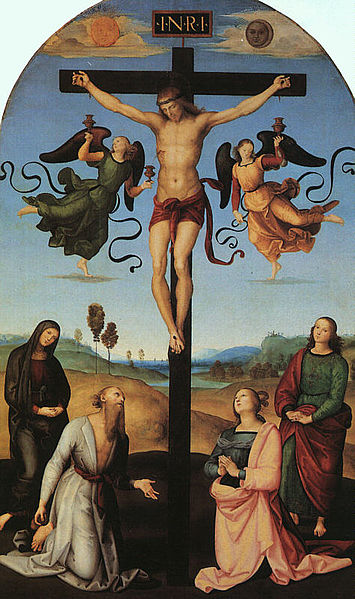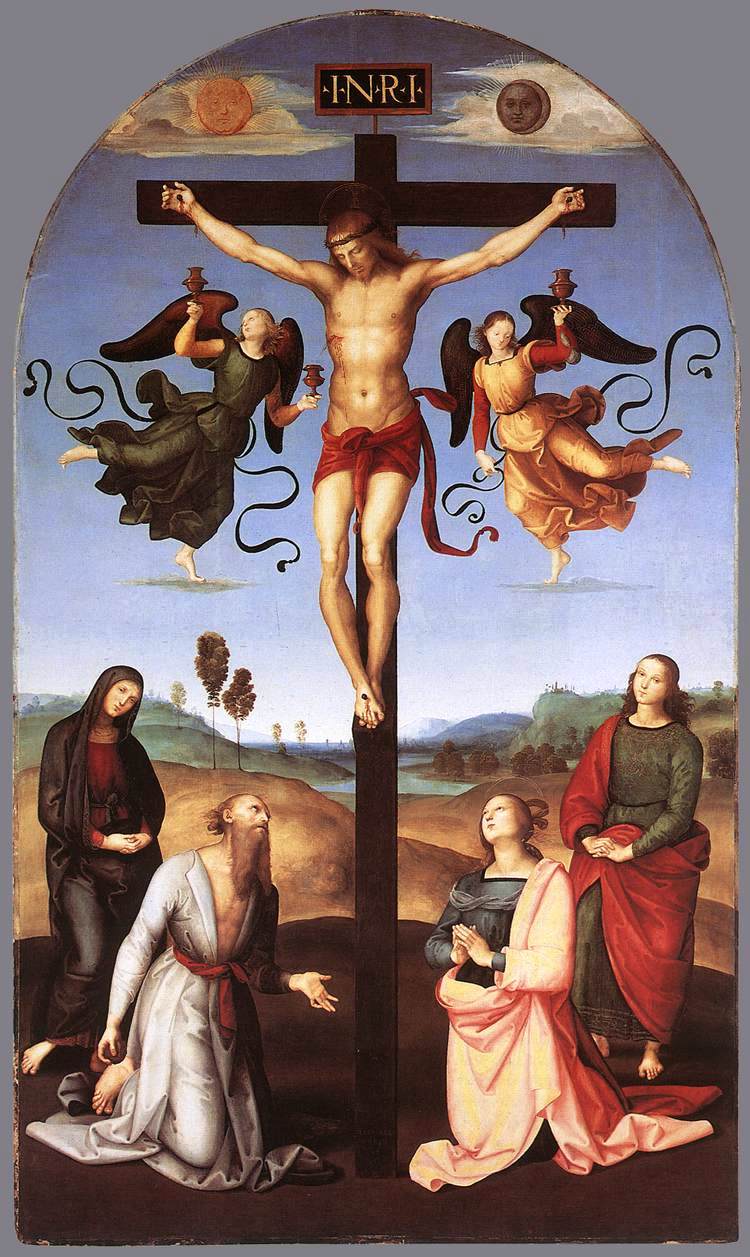 This article about the 'Mond' crucifixion, which is in the National Gallery in London, is another by Dr Caroline Farey of the Maryvale Institute. She and I worked together to design the Institute's degree level diploma (6US credits): Art, Inspiration and Beauty in a Catholic Perspective. A distance learning course requiring one residential weekend. This can be taken either by application to the Institute in Birmingham, England, or in the US through their centre based at the Diocese of Kansas City, Kansas, (email ecat2@archkck.org for details). In addition to these courses by the Institute, Thomas More College of Liberal Arts in New Hampshire has a summer programme run by myself. This programme includes an icon painting class and weekend retreats for artists, details here.
This article about the 'Mond' crucifixion, which is in the National Gallery in London, is another by Dr Caroline Farey of the Maryvale Institute. She and I worked together to design the Institute's degree level diploma (6US credits): Art, Inspiration and Beauty in a Catholic Perspective. A distance learning course requiring one residential weekend. This can be taken either by application to the Institute in Birmingham, England, or in the US through their centre based at the Diocese of Kansas City, Kansas, (email ecat2@archkck.org for details). In addition to these courses by the Institute, Thomas More College of Liberal Arts in New Hampshire has a summer programme run by myself. This programme includes an icon painting class and weekend retreats for artists, details here.
Caroline writes: Time and eternity, death and life, heaven and earth are represented here as contrasts or paradoxes and yet Raphael also presents them as in harmony.
Contrasts. Look now for as many contrasting elements as you can.Perhaps the most obvious is that of the sun and the moon both appearing together
Look for life and death contrasts.Do you notice that the most animated parts of the picture are the ribbons and dresses of the flying, dancing angels.These, the most alive are positioned closest to the dead figure of Christ.It is as though whatever is touched by the blood of Christ is given abundant life.
Look for time and eternity contrasts.Can you see that the people of the earth seem caught in a seemingly eternal stillness while the eternal beings, the angels, seem to be part of that moment in real time at the actual crucifixion catching Christ’s outpouring blood for every future Mass.
Look at the background contrasts of colour and content.The dark cross rises out of the dark, bare earth, passing barren but golden hills behind, passing on and up through water, always symbolic of Baptism, past a great city and on up into the skies where there is the sun and the moon are attending the great cosmic event of the death of their Creator.
Harmony
How does the painter hold the picture together and illustrate the harmony achieved by Christ through such an ignoble death?The heavy dark cross is the strong uniting feature.This is so theologically and so it is particularly appropriately pictorially as well.Christ’s death on the cross is the great act of love which purifies the created world in order to unite heaven and earth.It is this same act of unity that takes place at every Mass. In the painting it stretches from the top to the bottom of the picture.
The colour red has particularly strong significance. Every figure has a touch of red, every figure in the picture is pictorially touched and redeemed by the blood of Christ.
Other colours also link the elements of the picture.What are the colours in the top half of the picture that are repeated in the bottom half?The blue of the sky is picked up in St Jerome’s clothes; the green of one of the angels is also in St John’s garments; the gold of the second angel is in the sun and the hills and lights up the clo ak of St Mary Magdalene who is radiating light reflected from the sun but also the Son whose love changed her life; the colour of the flesh of all the figures binds them to the body of Christ whose flesh dominates the centre of the picture.
The painting is an altarpiece.It is designed for the Mass.
In a painting, people’s looks are often messages.In this painting the direction of each person’s gaze speaks a language of engagement for the sake of the congregation at Mass inviting them to join the scene at the cross.Let us begin with Jesus.He has his eyes closed so he is not looking at anything on this earth.His concentration we know is on his Father in Heaven.Now look at some of the others.What is the angel in green looking at? The angel in green turns our attention to Jesus’ blood.
Who is the angel in gold looking at?The angel in gold is looking at St John the gospel writer who is looking straight at us.
The two kneeling figures are St Jerome and St. Mary Magdalene.Who are they looking at? St Jerome and Mary Magdalene turn our attention to Jesus’ body on the cross.
The two standing figures are Our Lady and St John.Who are they looking at? When someone looks out at you from a painting he or she is trying to draw or invite you into the scene.Our Lady and St John are painted in a way that suggests that they are quietly hoping that we too will kneel or stand, and beg forgiveness like St. Jerome or adore and give thanks like St Mary Magdalene.
Almost everything in this painting is about the Mass: we gather together at Mass around the sacrifice of Christ on the cross; Mass brings us salvation through the cross; we kneel and worship at Mass like Mary Magdalene kneeling at the foot of the cross;we pray at Mass in different ways, such as asking forgiveness like St Jerome, adoring or thanking God, like Our Lady; we receive the blood of Christ in a chalice at Mass like the cups carried by the angels and, of course, angels are present at Mass.
I would add this one additional reference to the Mass in the comspositional design of the painting. If you trace a line through the four heads of the observers below to the outer feet of each angel and then to their heads, it traces the shape of a regular octagon. This is a visual reference to the 'eighth day' of creation - in which the birth, passion, death and resurrection of Our Lord ushers in the new age. My sense is that this is not intended by Raphael as a symbol to be read, so much as a design feature that he feels is appropriate to the subject and so enhance its beauty will naturally aid the communication of its message at an intuitive level. (DC)


